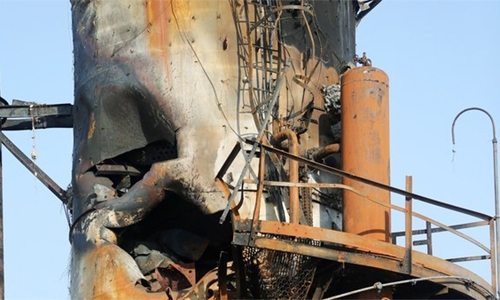Saudi Arabia shows attack site
Saudi Arabia yesterday took media to inspect oil facilities hit by attacks showing melted pipes and burnt equipment. The kingdom sees the Sept. 14 strikes on its Khurais and Abqaiq facilities — the worst attack on Gulf oil infrastructure since Iraq’s Saddam Hussein torched Kuwaiti oilfields in 1991 — as a test of global will to preserve international order. Responsibility was claimed by Yemen’s Houthi movement, an Iran-aligned group fighting a Saudi-led alliance in Yemen’s four-year-old conflict.
At Khurais, which the Saudi defence ministry says was hit by four missiles, reporters were shown repair work under way, with cranes erected around two burnt-out stabilisation columns, which form part of oilgas separation units, and melted pipes. “We are confident we are going back to the full production we were at before the attack (on Khurais) by the end of September,” Fahad Abdulkarim, Aramco’s general manager for the southern area oil operation, told reporters.
“We are working 24/7...This is a beehive.” The Khurais field and processing plant resumed 30 per cent of production within 24 hours of the strike and will produce 1.2 million barrels a day by the end of September, Fahad Al Abdulkareem said. Workmen wearing red high visibility jackets and white helmets moved through the site, a large compound the size of several football stadiums containing interconnected structures of piping and towers.
The assault affected four of its crude-stabilization units -- 90-meter (300-foot) towers that remove pressure and gas from the crude. One of two towers not visible on the site visit sustained even more severe damage than those on view, he said. Emergency crews arrived within 10 minutes of the first strike at Khurais, tackling fires as the attack continued, Al Abdulkareem said. A mound of blackened debris lay on the ground. An executive said the scorched mess once covered much of the ground but now only a small mound is left.
Some workers sprayed what appeared to be water on the ground. Mobile cranes and water trucks stood near the crumpled, mangled remains of a fire-damaged stabilisation tower. Saudi Minister of State for Foreign Affairs Adel al-Jubeir said on Thursday the attacks were an “extension of the Iranian regime’s hostile and outlawed behaviour”. Khurais produced 1.2 million barrels per day before the attack.
The attacks reduced nearly halved the kingdom’s output, shutting down 5.7 million bpd in production. Aramco has ramped up output at its offshore fields and is also tapping oil in storage to meet export commitments.
Related Posts

